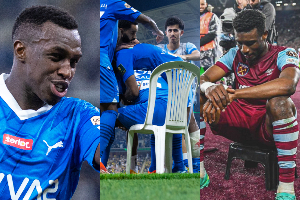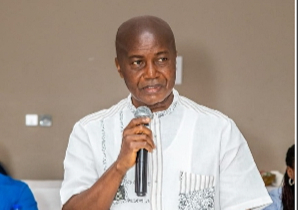- Home - News
- TWI News | TV
- Polls
- Year In Review
- News Archive
- Crime & Punishment
- Politics
- Regional
- Editorial
- Health
- Ghanaians Abroad
- Tabloid
- Africa
- Religion
- Election 2020
- Coronavirus
- News Videos | TV
- Photo Archives
- News Headlines
- Press Release
General News of Tuesday, 4 May 2004
Source: GNA
More slave children being rescued
Accra, May 4, GNA - Child-Slaves numbering 864 have been rescued from some districts in the country and reintegrated with their families within the last 18 months.
The rescue exercise took place in Kpando Torkor in the Volta Region, Senya Bereku in the Central Region, Ada, Ningo and Accra Metropolitan Area in the Greater Accra Region.
The children made up of 407 girls and 457 boys included those rescued from their slave-masters and those given out voluntarily. Mr Wilbert Tengey, Executive Director of the African Centre for Human Development (ACHD), announced this in Accra on Tuesday.
He was speaking at an Anti-Child Trafficking District sensitisation and Awareness Creation Forum attended by representatives of religious bodies, assembly members, civil society and queen mothers. The forum was to collate views and suggestions on child trafficking and how to help combat the menace.
Mr Tengey said the ACHD had been actively involved in undertaking practical actions to rescue children, who have been identified as being trafficked in the districts.
He said reception homes have been established in Kpando, Sogakope and Accra to rehabilitate the rescued children.
The children were first screened, interviewed and rehabilitated before they were re-integrated into their families and communities. Mr Tengey said; "after they are taken through psychotherapy, we convince their parents to accept them back while others are sent to school and the older ones recruited into apprenticeship programmes".
He explained that, since the Centre began addressing the issue of child trafficking in 1999, about 50,000 children were found in the category of those trafficked internally and those sold or transferred to Cote D'Ivoire, Togo, Burkina Faso and Nigeria.
Mr Tengey mentioned some of the problems being encountered to include, refusal of some parents to accept their rescued children back into the family due to stigmatisation.
Others were the unwillingness of some slave-masters to release such children unless they were bought back by rescuers and the inability of the rescued children to identify their families and homes.
He said in some cases, parents sold their rescued children back to slavery, saying; "in such situation, we inform the Police and they arrest such parents".
Mr Tengey called for a multidisciplinary approach to tackle the issue, which he described as a "big disgrace to the image of Ghana", stressing, "we should not politicise the issue".
However, Mr Tengey was grateful that the Government was promulgating a law on human trafficking, now in its final stages at the Attorney General's Department.
Under the law, offenders who deal in the sale and transfer of human beings of under or above 18 years, within or outside Ghana, would be arrested and prosecuted.
Madam Emelia Oguaah, Deputy Director of ACHD, said the ages of children rescued ranged between six and 12 years.
She said some of them were sold into slavery at a tender age of two years. They included children from other countries, who are sent to their countries after the necessary arrangements.
Madam Oguaah noted that most of the rescued children were either infected with Bilharzias or Sexually Transmitted Diseases (STDs), especially the girls.
She said while in slavery, some of them within the Accra Metropolis were mainly engaged in iced water selling, baby sitting for their masters, while those in the fishing areas were sent to sea and sometimes got drowned or left to die on the high sea.
Mr Stanley Nii Adjiri Blankson, Accra Metropolitan Chief Executive Officer, expressed the hope that the participants would come out with concrete ideas and suggestions that would help solve the nefarious trade in children.
Mrs Doris Archampong, Greater Regional Director of the National Commission for Civic Education (NCCE), called for the participation of traditional rulers in eradicating the menace since they were in direct contact with the people in the communities.










